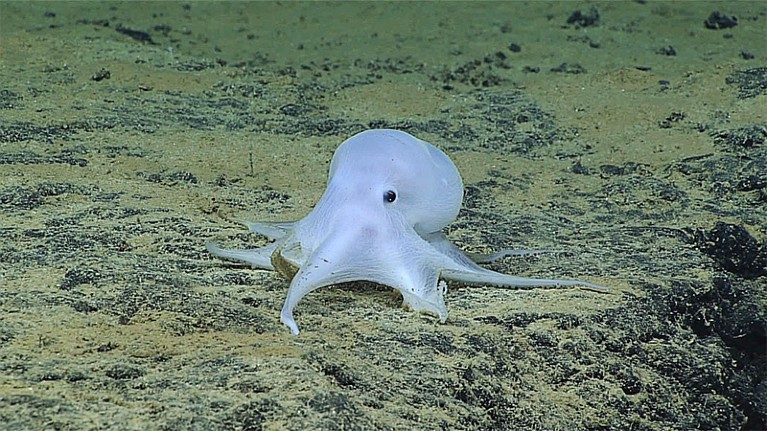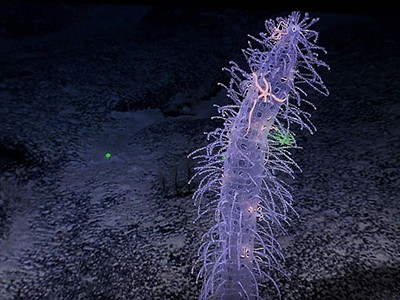
Deep-sea mining poses a serious threat to animals such as this octopod that live at the bottom of the ocean, many of which are yet to be identified.Credit: Planetpix/Alamy
Last week, the scaly-foot snail (Chrysomallon squamiferum) became the first species to be officially classified as ‘endangered’ by the threat of deep-sea mining. The creature, which has been added to the International Union for Conservation of Nature’s Red List of Threatened Species, occupies three known locations, all in the western Indian Ocean. Each is in a deep fissure known as a hydrothermal vent, and these locations include candidate sites for mining.
The potential to mint money from mining the ocean floor has long existed. Now, thanks to tech industries’ growing need for rare metals such as molybdenum and lithium, the practice is expected to take off within a decade.
Around 1.3 million square kilometres of the sea bed have already been contracted out to governments and companies for mining exploration, work that poses a risk to thousands of species, many of them not yet even known. Surveys of deep-sea areas slated for mining have identified more than 1,000 animal species, and these surveys have scanned less than 0.01% of the ocean floor.
Nonetheless, the International Seabed Authority (ISA) — the body that oversees deep-sea mining in international waters — expects to finalize its mining code by 2020, allowing companies to move to the next step, which is commercial extraction.
Seabed mining is coming — bringing mineral riches and fears of epic extinctions
The difficulty is that the ISA has a mandate both to protect the international sea bed and to exploit it. Marine scientists are concerned that the authority is putting more emphasis on its development mandate, and not enough on its environmental remit.
In an open letter sent to the ISA, which is meeting in Kingston, Jamaica, this week, 28 marine scientists from around the world are calling on the organization to turn to independent scientists when evaluating requests from companies and governments for deep-sea-mineral exploration. They also suggest that the ISA works more closely with influential intergovernmental bodies such as the United Nations Convention on Biological Diversity, so that the ISA’s conservation voice is strengthened in talks with companies.
These are sensible recommendations, which should be supported. Mining’s destructive potential extends beyond the loss of individual charismatic species. The use of tractor-sized machines, each weighing around 300 tonnes, could release carbon locked up in deep-sea sediments into the atmosphere, worsening climate change.
The deep ocean is so poorly sampled that researchers don’t even know how much might be lost through mining activities. Next month, scientists and industrialists will run a 3.5-tonne prototype nodule harvester — a kind of combine harvester for the ocean — which will crawl along the Mediterranean sea bed while monitoring the dispersing sediment and its potential to smother living organisms.
But a trial environmental assessment planned by the Belgian contractor Global Sea Mineral Resources in the Pacific Ocean in April was called off owing to technical problems, although there is still time to carry out this test.
Many more robust assessments must be planned, and soon — especially those that bring together science, conservation, industry and regulators. Moreover, the ISA should accept offers from researchers to help write and evaluate the rules for extractive industries before mining takes off.
A decade will pass quickly. The time must be used wisely to ensure a better understanding of what could be destroyed in the blinkered pursuit of ocean riches.

 Seabed mining is coming — bringing mineral riches and fears of epic extinctions
Seabed mining is coming — bringing mineral riches and fears of epic extinctions
 Ocean snail is first animal to be officially endangered by deep-sea mining
Ocean snail is first animal to be officially endangered by deep-sea mining
 Red Listing can protect deep-sea biodiversity
Red Listing can protect deep-sea biodiversity
 Forty years of fathoming life in hot springs on the ocean floor
Forty years of fathoming life in hot springs on the ocean floor







